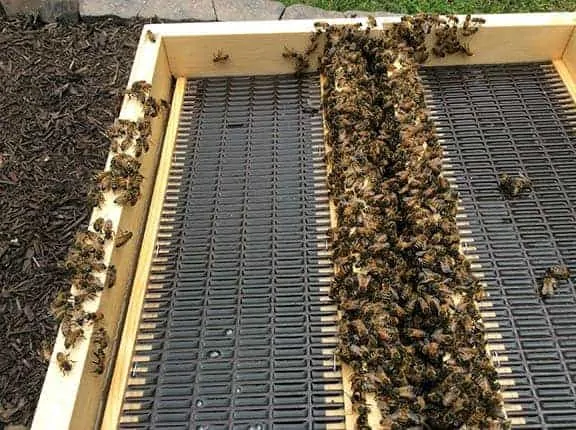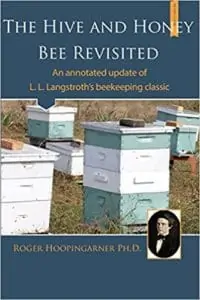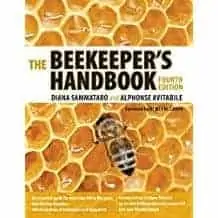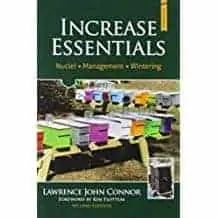Last week, we rounded out our discussion about preparations for fall and winter. We also discussed what robbing behavior is and how a beekeeper might deal with it.
This week, I put in place a couple of techniques to stop the robbing attacks. Those techniques appear to have worked as I will relate shortly. So, this week, I want to shift gears and talk about some educational resources available to new beekeepers including books, the web, and more.
During the winter, we can’t really be working our bees (or most of us can’t!). So winter is a great time to settle in and learn more about these amazing creatures. But, before I share some thoughts about resources I am using, let’s talk about what happened in Beorn’s Acres Apiary this week.
Hive Updates
My colonies continue to produce tons of winter stores. In fact, two of my colonies decided they wanted to put some burr comb in place to connect their honey stores.
I thought this week’s inspections would be easy but I was so wrong!! But, there is good news from the nucleus hive. And, it has a newly named queen. So let’s talk about what I’m seeing in the bee yard lately.
Nucleus Hive (Hive Rome)
So, I’m sensing a decidedly Italian focus in my apiary. It rather makes sense, given that I have three Italian queens and one Italian-Carniolan cross queen. So, this week, I cast about for names for the new queen and for her hive.
I was struggling mightily looking at famous queens, sorceresses, and pretty much the whole gamut of possibilities. So it was time to ask some friends for their suggestions and the suggestions were intriguing.
I finally settled on Hive Rome with my queen receiving the name of Julius Caesar’s wife, Cornelia. Now, if I can just remember the name…
After weeks of worrying and nail-biting, I can now report that this small colony is queenright. And not only is it queenright, but Cornelia is actively producing brood. Seeing eggs and larvae for the first time in weeks was exciting during this inspection! So, let’s recap how we got here.
This last week started with ongoing robbing attacks. So, I went to the local bee shop and purchased a nuc robbing and moving screen (there’s a funny story with this coming!). But, even after installing it, I saw the robber bees continuing to return.
Day after day, the robbing bees returned to this small colony much to my exasparation. So this exasperated beekeeper spritzed them with cold water. That really does work. Off they went to their own hive leaving my little nuc alone.
The attacks have continued off and on even after I moved the hive to the front yard. But, the good news is that the robbing screen did its trick.
The last three days I’ve watched to see if it was going to work. It did. The robbers clustered on the mesh front while the actual inhabitants went in and out the entrance at the top of the screen. The entrance is much smaller, making it very easy for the colonies guards to ward off marauding honeybees or yellow jackets.
Feed, Feed, and Feed
Finally, everything is beginning to look good in this small colony except honey stores. They are very low on honey stores thanks to all the robbing activity. So, to assist Cornelia and her workers, I am constantly keeping the hive top feeder filled. The last few days has been 1:1 sugar water. They will get 2:1 sugar water this week.
With these developments, I have to get their hive ready to transfer them before winter!
Having a Blond Moment Installing a Robbing Screen
So, a funny thing happened along the way to installing my new moving and robbing screen on the nuc.
On Tuesday, I installed the moving and robbing screen which seemed to put an end to the robbing activity. What a happy beekeeper I was! I also took the time to move the nuc to the front yard garden to further confuse the robbers. I’m sure everyone in the neighborhood was enjoying watching the crazy beekeeper carry a small hive of bees through the rose garden without a suit on. Not one sting!
Once I had it in place I watched for the next three days and could not figure out why there didn’t seem to be much coming and going from the colony. And wondered why they ate so much sugar water in three days. Well, this guy had managed to forget to remove the nuc entrance reducer which I discovered Sunday afternoon!
I looked in the robbing screen and saw that there was barely a crack for the bees and saw two little eyes looking out of the crack forlornly. So I removed the robbing screen to remove the entrance reducer. Of course, you all know what happened, a boiling mass of bees buzzing FREEDOM!
I got the robbing screen back in place and now we have coming and going all over again. Whew!
Hive Acquitaine
Hive Acquitaine is beginning to get in better position for winter. The workers have been busy drawing comb on at least four frames in the medium box. And, this week they have begun to store honey in that comb.
This discovery was quite exciting. But, they are going to need some assistance to develop a medium box honey dome for winter. So, to assist there efforts I am going to move two frames each from Hive Olympus and Hive Florence to give them four frames of honey and giving them less work to do to get ready for winter. You’ll understand why I have decided to do this when you read about the other two hives!
The bees had nearly drained the top hive feeder. I will be refilling it early Monday morning. This week they are getting the 2:1 sugar water mix.
As I moved past the medium box into the second brood box, I observed some pleasing developments. The upper brood box has significant stores of both honey and brood. Eggs were present, indicating that Eleanor had been also present recently. However, for the second time in three inspections, Eleanor evaded my roving eyes! She is becoming quite the elusive queen of late.
This colony has a very healthy population of workers. They have also formed queen cups on a number of frames in both the upper and lower brood boxes. But, absolutely all of them were empty. Eleanor is definitely not ready to create queens.
The lower brood box had significant stores of honey as well as brood. I will need to do some rebalancing as I near my last inspection before winter. I repositioned a few of the Apivar strips and had to install a fourth strip due to the amount of brood.
Hive Olympus
Naughty, naughty girls!
That was actually what I said when I got past the top hive feeder and began working this hive. And yes, I talk to my bees while I’m working them.
The colony had drained the top hive feeder which I will be refilling Monday morning. They have also almost completely filled the medium box with honey. But, they also decided that it would be a great idea to build burr comb connecting the bottoms of the medium frames to the tops of the upper brood box’s frames. And of course, they filled that burr comb FULL of honey.
It was truly a bear cleaning that out so that I could complete the inspection. It was also fairly messy to boot!
After clearing the burr comb, I turned my attention to the upper brood box. There were some interesting discoveries here! There are significant amounts of honey stores in this box along with a fairly significant amount of brood. I found Athena in the upper brood box as well.
Likewise, the lower brood box has plenty of honey stores as well as significant amounts of brood. I repositioned the Apivar strips due to the movement of the brood.
There was so much honey in this hive that it is a bit honey-bound at this point. I’ll assist it by removing two medium frames of honey for Hive Acquitaine. I will also add a couple of deep frames of honey to Hive Rome when I move it into its new hive. That will give this colony room to store more honey in the leadup to winter.
Everything looks great in this colony! So, I reassembled the hive and moved on to Hive Florence.
Hive Florence
This Hive had partially drained the top hive feeder. They have not been eating as much of the sugar water as the other colonies for a while now. There were also clear signs of small hive beetle larvae. I will likely have to clean out the sugar water and replace it with fresh water.
The medium box is overflowing with honey stores. So much so that I will gift two frames from this medium box to Hive Acquitaine. Just like Hive Olympus, this colony had drawn burr comb connecting the medium box’s frames to the upper brood boxes deep frames. Sighing, I went to work clearing out the burr comb.
As with Olympus, this hive has significant stores of honey and plenty of brood in the upper brood box. I found Beatrice II wondering on the last frame in the upper deep box. As it was getting late in the afternoon by the time I completed my work, I didn’t inspect the lower brood box this week. I will need to do that next week to see if I need to rebalance the frames. There is more than enough honey to share a deep frame or two of honey with Hive Rome.
The bees in all of my colonies are definitely exhibiting normal behavior for fall. During fall, our bees are sitting on significantly large stores of honey. They know this is their winter food and are naturally very protective of this food store. As a result, they are irritable and easily agitated.
But, if you use smoke, take your time, and move carefully while working the bees they are not overly aggressive. So for the next few weeks my mantra will be feed, feed, feed!
Let’s get them ready for winter.
Educational Resources for New Beekeepers
There are many types of educational resources available to new beekeepers including books, online forums and blogs, and local beekeeping clubs. For this post, I want to compile a list of useful books and online resources for new beekeepers. But, I cannot stress enough the usefulness of joining your local beekeeping club.
Useful Books
Let’s talk about some books that are in my library that I have found useful in learning as much as I can about my bees.
Please note that, in some cases, purchasing these books via these links may help keep the lights on at PerfectBee, at no additional cost to you.
First Lessons in Beekeeping
This book is often the first book that new beekeepers read. In fact, when I joined out local beekeepers club, this was the book they suggested as my first for reading and getting an introduction to beekeeping. This book has been published for decades by Dadant & Sons. The first edition was written by Charles P. Dadant in 1917. It has been updated periodically ever since its first publication. The current edition was written by Keith Delaplane who updated it for modern beekeeping techniques. He is a professor of entomology and the head of the honey bee research and extension lab at the University of Georgia. In my opinion, this book should be the first book a new beekeeper reads.
Delaplane, Keith S. 2007. First Lessons in Beekeeping. Hamilton: Dadant & Sons. ISBN #978-0-915698-12-7.
The Hive and Honey Bee Revisited
The Hive and the Honey Bee is a classic work originally written by L. L. Langstroth. Langstroth’s original work was written more than 150 years ago. This edition preserves the original book in its original text and illustrations but is updated and annotated by one of the premier researches in apiculture, Dr. Roger Hoopingarner. This book keeps alive beekeeping techniques from the past and offers lessons for modern beekeepers. It is also required reading for those of us seeking certifications. Dr. Hoopingarner is the Michigan State University Professor Emeritus of Entomology and has specialized in apiculture for 65 years. His research includes work on bee diseases, varroa population dynamics and control, and pollination systems just to name a few. If you want to have THE classic book on your shelf, this is a definite must!
Hoopingarner, Roger. 2014. The Hive and Honey Bee Revisited: An annotated update of L. L. Langstroth’s beekeeping classic. Kalamazoo: Wicwas Press. ISBN #978-1-878075-36-9.
The Backyard Beekeeper
The Backyard Beekeeper is now in its third edition and is an excellent work for a beginning beekeeper. This book takes a modern look at traditional beekeeping including lots of high quality photos, great diagrams, clearly written text, and filled with good beekeeping information. It contains a step-by-step guide to getting started, a new section on the “25 Rules of Modern Beekeeping”, plenty of facts about bees, information on top bar hives, and an expanded section on urban beekeeping. Flottum also spends significant time discussing integrated pest management as well as specific techniques for controlling Varroa Mites. Kim Flottum has been the editor of Bee Culture for thirty years. This book is a good choice for a beginning beekeeper to read.
Flottum Kim. 2014. 3rd Edition. The Backyard Beekeeper: An Absolute Beginner’s Guide to Keeping Bees in Your Yard and Garden. Beverly: Quarry Books. ISBN #978-1-59253-919-2.
Homegrown Honey Bees
Homegrown Honey Bees is a great little book that walks a new beekeeper, or a prospective new beekeeper, through the first year of beekeeping. This book is a highly visual reference book walking a new beekeeper through choosing equipment and the first year of beekeeping. In fact, this was the first book I read on beekeeping as a “prospective” beekeeper. I picked it up on a lark while consulting for my day job. Alethea Morrison’s zeal for beekeeping was infectious enough that I decided to become a beekeeper after finishing this book.
Morrison, Alethea. 2013. Homegrown Honey Bees: An Absolute Beginner’s Guide to Beekeeping Your First Year, from Hiving to Honey Harvest. North Adams: Storey Publishing. ISBN #978-1-60342-994-8.
Beginning Beekeeping
Beginning Beekeeping is another highly visual guide to beekeeping. It focuses on teaching the reader the basics to helping your colonies thrive and survive. Phillips discusses the pros and cons of different types of hives, the various products that can be harvested from the hive, inspecting hives and maintaining queenright colonies, methods for protecting your bees, as well as troubleshooting techniques for common and difficult problems. Tanya Phillips manages around 150 colonies in central Texas, owns Bee Friendly Austin, and was the founder of the Travis County Beekeepers Association. I have not read through this work yet but it looks to be a useful starter book for new beekeepers.
Phillips, Tanya. 2017. Beginning Beekeeping: Everything You Need to Make Your Hive Thrive! New York: DK Publishing. ISBN #978-1-46545-453-9.
Beekeeping for Dummies
I have been a long-time fan of the Dummies series of books. But this book is a For Dummies book of a different type. It contains all the usual features of a book in this series but it is full of useful information that often delves much deeper than most books on beekeeping. Now in its 4th edition, this work focuses on providing you details on starting and managing backyard colonies with practical and up-to-date information on apicultural topics. There are also online hot-to beekeeping videos associated with this book. The author, Howland Blackiston, has been a backyard beekeper since 1984 and also authored Building Beehives for Dummies. I highly recommend you purchase this book. For me, it is a great reference book when I need a quick response to an issue I’m experiencing in the apiary.
Blackiston, Howland. 2017. 4th Edition. Beekeeping for Dummies. Hoboken: John Wiley & Sons, Inc. ISBN #978-1-119-31006-8.
The Beekeeper’s Handbook
The Beekeeper’s Handbook has gone through multiple editions over the past 35 years. It was designed to be “the best single-volume guide to the hobby and profession of beekeeping.” The fourth edition was redesigned, expanded, update, and revised to incorporate the latest information on Colony Collapse Disorder, green IPM methods, regional overwintering protocols, and procedures for handling bees and managing diseases and pests such as Africanized honey bees and bee mites. The book is co-authored by two scientists who study bees as part of their profession. I haven’t had a chance to read through this work yet but it is on my winter reading list.
Sammataro, Diana, and Alphonse Avitabile. 2011. 4th Edition. The Beekeeper’s Handbook. Ithaca: Cornell University Press. ISBN #978-0-8014-7694-5.
The Beekeeper’s Problem Solver
The Beekeeper’s Problem Solver compiles 100 common problems that face beekeepers. Each problem is described including the underlying causes and practical solutions to the problem. Each key area of beekeeping is covered with photographs, tips, and very useful information. This is a book you pick up when you want a quick answer to a common problem. The 100 problems are broken across nine chapters: Beekeeping Basics, Beekeeping Equipment, Biology and Behavior of the Colony, Managing and Manipulating Hives, Queen Production and Maintenance, Diseases and Pests of Honey Bees, Pollen and Pollination, Producing and Processing Honey, and Beeswax, Propolis and Specialty Issues.
Tew, James E. 2015. The Beekeeper’s Problem Solver. Beverly: Quarry Books. ISBN #978-1-63159-035-1.
Honeybee Democracy
Honeybee Democracy should be on your reading list for winter. I haven’t had a chance to read this volume yet but intend to over the winter. The cover flap of the book sums up why you will want to read this work: “Honeybees make decisions collectively–and democratically. Every year, faced with the life-or-death problem of choosing and traveling to a new home, honeybees stake everything on a process that includes collective fact-finding, vigorous debate, and consensus building. In fact, as world-renowned animal behaviorist Thomas Seeley reveals, these incredible insects have much to teach us when it comes to collective wisdom and effective decision making. A remarkably and richly illustrated account of scientific discovery, Honeybee Democracy brings together, for the first time, decades of Seeley’s pioneering research to tell the amazing story of house hunting and democratic debate among the honeybees.” Thomas D. Seeley is a professor of biology at Cornell University and is also a beekeeper. He also has other works about honeybees including The Wisdom of the Hive and Honeybee Ecology.
Seeley, Thomas D. 2010. Princeton: Princeton UP. ISBN #978-0-691-14721-5.
Increase Essentials
Lawrence Connor’s Increase Essentials is a useful addition to your library if, like me, you are interested in producing nucleus colonies and producing local queens. This book explains the techniques beekeepers might follow to use “nuclei to solve problems in the beeyard, use them to winter colonies and provide a reliable source of fresh bees, locally acclimatized queens, replacement hives and colonies for operational growth or sale.” This second edition updates the prior edition with new techniques and developments in making nuclei colonies. I haven’t had a chance to read this work yet as I just picked it up last week but this is another one of interest to beekeepers.
Connor, Lawrence John. 2014. 2nd Edition. Increase Essentials: Nuclei – Management – Wintering. Kalamzoo, Wicwas Press. ISBN #978-1-878075-35-2.
Other Notable Books
- Caron, Dewey M., and Lawrence John Connor. Revised Edition. Honey Bee Biology and Beekeeping. Kalamazoo: Wicwas Press. ISBN #978-1-878075-29-1.
- Root, A. I., Ann Harman, Hachiro Shimanuki, and Kim Flott. 2007. The ABC & XYZ of Bee Culture: An Encyclopedia Pertaining to the Scientific and Practical Culture of Honey Bees.
- Connor, Lawrence John. Queen Rearing Essentials.
- Connor, Lawrence John. Bee Sex Essentials.
- Laidlaw, Harry. Contemporary Queen Rearing.
- Blackiston, Howland. Building Beehives for Dummies.
For Beekeepers Who Garden
There are also a number of great books for those of us who are both avid flower gardeners and beekeepers. We can plant things in our gardens that will assist in feeding our bees during spring, summer, and fall.
The following books are worth a look:
- Lindliner, Peter. Garden Plants for Pollinators.
- Lee-Mäder, Eric, Jarrod Fowler, Jillian Vento, and Jennifer Hopwood. 2016. The Xerces Society. 100 Plants to Feed the Bees: Provide a Healthy Habitat to Help Pollinators Thrive. North Adams: Storey Publishing. ISBN #978-1-61212-701-9.
- Frey, Kate, and Gretchen LeBuhn. 2016. The Bee-Friendly Garden. Berkeley: Ten Speed Press. ISBN #978-1-60774-763-5.
- Weidenhammer, Lori. 2016. Victory Gardens for Bees: A DIY Guide to Saving the Bees. Madeira Park: Douglas & McIntyre. ISBN #978-1-77162-053-6.
Beekeeping Magazines
There are two primary magazines available to beekeepers. Either contain lots of useful information and makes a great educational resource for new beekeepers. Check them out here:
Useful Online Educational Resources
There are a host of useful websites replete with very solid information about beekeeping. I have compiled a list of reputable sites with solid information about beekeeping.
- PerfectBee – This is a no brainer. I have valued what I learned in their free course for new beekeepers. And beyond that there is a wealth of information at your fingertips.
- Honey Bee Health Coalition
- Center for Pollinator Research
- Bee Informed Partnership
National and International Associations
- American Beekeeping Federation
- Eastern Apicultural Society (EAS)
- International Bee Research Association (IBRA)
- Mid-Atlantic Apiculture Research and Extension Consortium (MAAREC)
- American Honey Producers Association (AHPA)
U.S. Honeybee Research Labs
- Bee Research Laboratory – Beltsville, Maryland
- Honey Bee Breeding, Genetics & Physiology Lab – Baton Rouge, Louisiana
- Pollinating Insects Research Unit – Logan, Utah
Natural and Sustainable Beekeeping
- The Bee Space – Smart, Simple & Sustainable beekeeping blog
- Natural Beekeeping
- Bush Farm Bees – Michael Bush’s blog on natural beekeeping
Hive Management
- Hive Tracks – Web-based hive management software (Located in Western NC) – I use this tool and I love it!
- BeeTight – Web-based & Mobile App hive management software
- BeeCloud – Cloud-based hive management software
Coming Next Week
Next week, I will update you on the progress of Hive Rome and its new queen Cornelia. I will also give you an update about how Hives Acquitaine, Olympus, and Florence are doing in preparing themselves for winter.
In addition, I will be talking about plants for pollinators. Prepare yourselves as your faithful blogger is about to wed his passion for gardening with his passion for beekeeping. Be very afraid!
Until next time, Happy Beekeeping!












